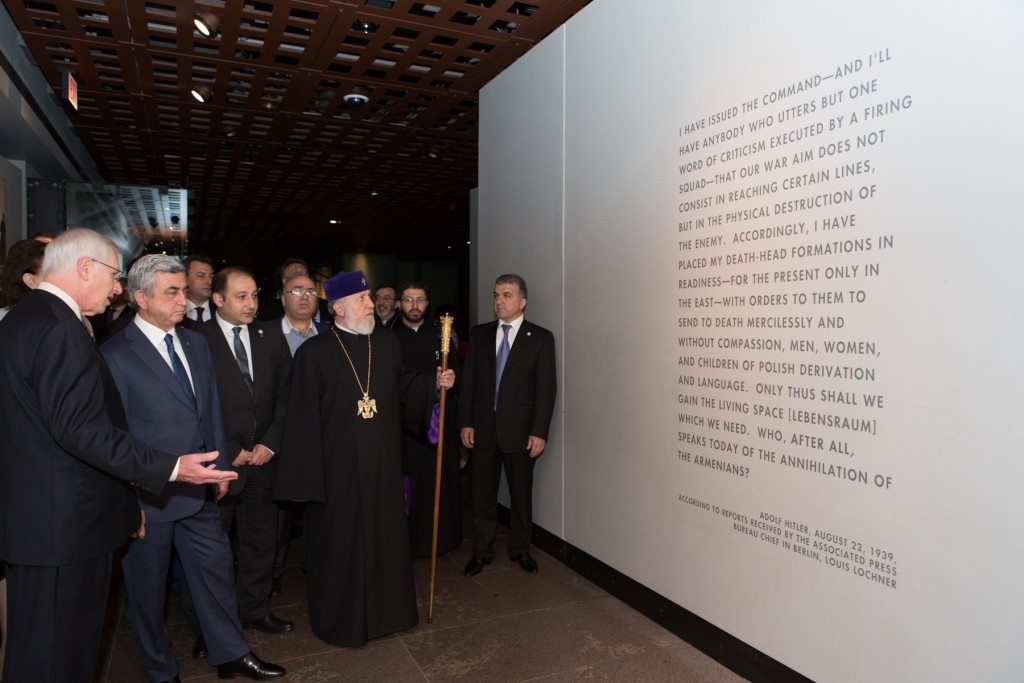WASHINGTON—On May 6, Armenia’s President Serge Sarkisian visited the U.S. Holocaust Memorial Museum as part of his three-day trip to Washington, D.C. The President’s visit took place on the eve of the U.S. commemoration activities marking the 100th anniversary of the Armenian Genocide. From May 7-9 in Washington, D.C., the National Commemoration of the Armenian Genocide Centennial is hosting a series of events commemorating the anniversary. Thousands will gather from across the country, and internationally, to join in remembering and honoring those lost in the genocide 100 years ago.

Arthur Berger, Senior Advisor to the United States Holocaust Memorial Museum, leads Armenian President Serge Sarkisian; His Holiness Karekin II, Supreme Patriarch and Catholicos of All Armenians; the Armenian Foreign Minister and Minister of Diaspora Affairs; Archbishop Khajag Barsamian, the Primate of the Eastern Diocese; and others on a tour of the U.S. Holocaust Memorial Museum. (Photo: U.S. Holocaust Memorial Museum)
“It was an honor to have the opportunity to visit this memorial and museum. We, Armenians, Jews, sons and daughters of other nations that have survived genocides shall continue working together to fight for recognition, condemnation of all genocides and other crimes against humanity, as that is the most efficient way of preventing them in the future,” said Sarkisian.

Arthur Berger, Senior Advisor to the United States Holocaust Memorial Museum, leads Armenian President Serge Sarkisian; His Holiness Karekin II, Supreme Patriarch and Catholicos of All Armenians; the Armenian Foreign Minister and Minister of Diaspora Affairs; Archbishop Khajag Barsamian, the Primate of the Eastern Diocese; and others viewing the Tower of Faces exhibit (Photo: U.S. Holocaust Memorial Museum)
U.S. Holocaust Memorial Museum Statement on Armenian Genocide
Last month the U.S. Holocaust Museum issued a statement on the Centennial of the Armenian Genocide.
Below is the full text of the statement:
Museum Statement on the 100th Anniversary of the Armenian Genocide
WASHINGTON—On the 100th anniversary of the Armenian Genocide, the United States Holocaust Memorial Museum remembers the suffering of the Armenian people. The Ottoman government, controlled by the Committee of Union and Progress (İttihat ve Terakki Cemiyeti), systematically eliminated the Armenian ethnic presence in the Anatolia region of its empire. Between the spring of 1915 and the end of autumn 1916, Ottoman authorities arrested, deported, conducted mass killings, and created conditions intended to cause widespread death among Armenian Christians.
At least 664,000 and possibly as many as 1.2 million Armenian men, women, and children died in massacres, in individual killings, or as a consequence of systematic ill-treatment, exposure, starvation, and disease. Knowledge of these atrocities quickly spread around the world and aroused widespread activism and even protests from representatives of the Ottomans’ World War I allies, Germany and Austria-Hungary.
The origins of the term “genocide” rest, in part, in the events of 1915–16 in Anatolia, then part of the Ottoman Turkish Empire. Polish-Jewish lawyer Raphael Lemkin highlighted early exposure to the history of Ottoman attacks against Armenians, anti-semitic pogroms, and other cases of targeted violence as key to his beliefs about the need for the protection of groups under international law. Inspired by the murder of his own family during the Holocaust, Lemkin tirelessly championed this legal concept until it was codified in the United Nations Convention on the Prevention and Punishment of the Crime of Genocide in 1948.
An accurate understanding of history rests on objective research conducted by scholars of all nationalities and disciplines. The Museum calls on all governments and private institutions to make freely available complete archives relevant to these events.

Arthur Berger, Senior Advisor to the United States Holocaust Memorial Museum, leads Armenian President Serge Sarkisian; His Holiness Karekin II, Supreme Patriarch and Catholicos of All Armenians; the Armenian Foreign Minister and Minister of Diaspora Affairs; Archbishop Khajag Barsamian, the Primate of the Eastern Diocese; and others stand in front of a quote from Adolf Hitler that references the Armenian Genocide. (Photo: U.S. Holocaust Memorial Museum)
The post Armenian President Visits U.S. Holocaust Memorial Museum appeared first on Armenian Weekly.